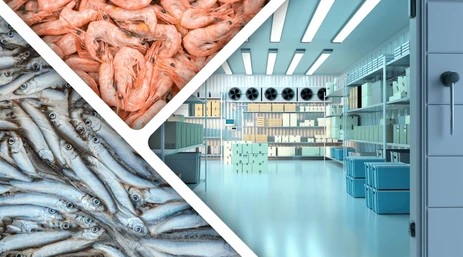Introduction
Seafood Refrigeration Solutions is one of the most perishable food products, requiring strict temperature control at every stage of handling, storage, and transportation. From the moment seafood is caught, it begins to deteriorate due to enzymatic activity, microbial growth, and oxidation. Without proper refrigeration, seafood can spoil quickly, leading to financial losses, food waste, and potential health hazards. The seafood supply chain involves multiple stages, including fishing, processing, storage, transportation, and retail display. At each stage, maintaining the right temperature is essential to preserve the freshness, texture, and nutritional value of seafood products. Refrigeration solutions, such as blast freezers, cold storage rooms, refrigerated transport, and ice machines, play a crucial role in slowing down spoilage and ensuring that seafood reaches consumers in its best condition.
Types of Seafood Refrigeration Solutions
Blast Freezing
- Process: Blast freezers use high-velocity cold air (-40°C or lower) to freeze seafood rapidly, minimizing the formation of large ice crystals. This helps preserve the cellular structure, texture, and taste of seafood.
- Applications: Commonly used for bulk freezing of fish, shrimp, lobsters, and shellfish for export or long-term storage.
- Benefits: Prevents freezer burn, retains moisture content, and ensures better quality compared to slow freezing.
Cold Storage Rooms
- Process: Cold storage rooms maintain controlled temperatures between -18°C and 0°C, depending on the type of seafood being stored. These large-scale refrigeration units are used to store fresh and frozen seafood before distribution.
- Applications: Seafood processing plants, wholesale seafood suppliers, and distribution centers.
- Benefits: Provides a stable and safe environment for large quantities of seafood, reducing spoilage and extending shelf life.
Chilled Display Cases
- Process: These refrigeration units keep seafood at temperatures between 0°C and 4°C, ensuring that fresh seafood remains visually appealing and safe for purchase.
- Applications: Found in supermarkets, fish markets, and restaurants.
- Benefits: Keeps seafood fresh while allowing customers to view the products, enhancing sales and customer satisfaction.
Ice Machines
- Process: Produces crushed, flake, or block ice to keep seafood cool during transportation, processing, and display. The ice absorbs heat and slows down bacterial growth.
- Applications: Fishing boats, seafood processing facilities, fish markets, and restaurants.
- Benefits: Provides flexible cooling options, especially in areas where refrigeration units may not be feasible.
Refrigerated Transport
- Process: Refrigerated trucks, containers, and ships maintain the cold chain from fishing vessels to distributors and retailers. These units operate at controlled temperatures, preventing seafood from warming up during transit.
- Applications: Used for both domestic and international seafood transportation.
- Benefits: Ensures that seafood reaches its destination without spoilage, preserving its quality for consumers.
Benefits of Proper Seafood Refrigeration
Extended Shelf Life
- Proper refrigeration slows down enzymatic and bacterial activity, preventing seafood from spoiling quickly.
- Allows seafood to be stored for longer periods, reducing waste and increasing profitability for suppliers and retailers.
Maintains Quality and Texture
- Preserves the natural taste, moisture content, and texture of seafood.
- Prevents dehydration and freezer burn, which can negatively impact the appearance and flavor of seafood products.
Prevents Bacterial Growth
- Seafood is highly susceptible to bacterial contamination, especially at temperatures above 5°C.
- Keeping seafood at low temperatures reduces the risk of foodborne illnesses and ensures consumer safety.
Reduces Waste and Financial Loss
- Proper refrigeration minimizes spoilage, reducing product loss for businesses.
- Increases revenue by ensuring that more seafood reaches consumers in optimal condition.
Ensures Compliance with Food Safety Standards
- Adhering to cold chain management regulations helps businesses comply with food safety laws and industry guidelines.
- Prevents potential fines, recalls, and reputational damage due to spoiled or contaminated seafood.
Conclusion
Seafood Refrigeration Solutions effective seafood refrigeration is essential for maintaining product quality, safety, and profitability in the seafood industry. Without proper temperature control, seafood can quickly become unsafe for consumption, leading to significant financial losses and health risks. By implementing advanced refrigeration solutions such as blast freezing, cold storage rooms, refrigerated transport, and ice machines, businesses can ensure that seafood remains fresh from catch to consumer. Proper refrigeration not only extends the shelf life of seafood but also preserves its taste, texture, and nutritional value. Additionally, it helps businesses comply with strict food safety standards, reducing the risk of bacterial contamination and foodborne illnesses.

